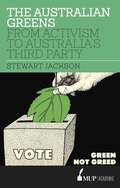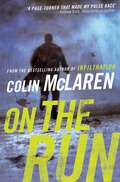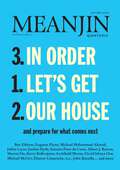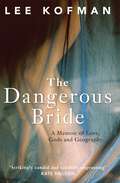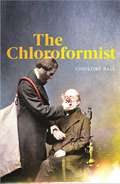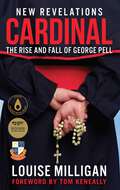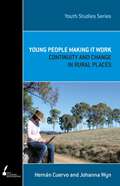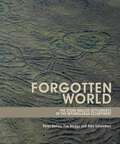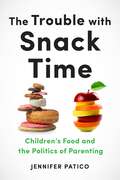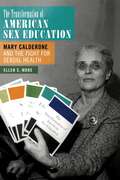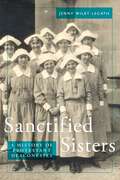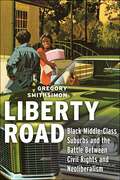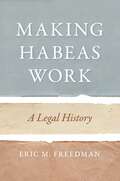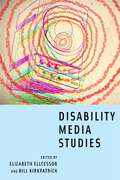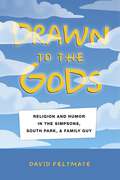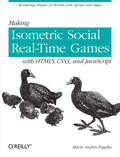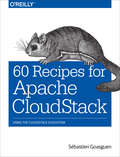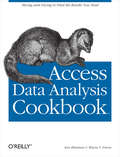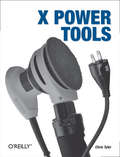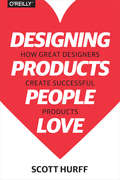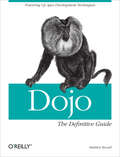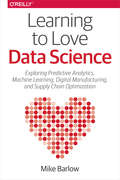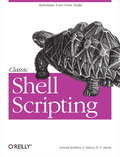- Table View
- List View
Australian Greens: From Activism to Australia's Third Party
by Stewart JacksonThe Australian Greens played a pivotal role after the 2010 federal election. It ensured the Gillard minority government went full term and won its first House of Representatives seat. But what do we really know about the Greens in Australia? Is the party really just an extension of the environment movement or a professional party, capable of influencing the major parties? This book examines the people who make the party tick. Uncovers the members and activists of the party. The Australian Greens: From Activism to Australia's Third Party asks whether the Greens has made the transition from a home for tree-huggers and alternative lifestylers to a party ready to work in Government.
On The Run
by Colin McLarenCole Goodwin spent years undercover, infiltrating the Mafia and putting the Australian Godfather behind bars for twenty years. As his team celebrate the 'guilty' verdict, the Mafia are rolling out a vendetta, aided by Cole's corrupt boss. The dodgy Inspector Mack has plans for a prosperous retirement in France, and wants Cole out of his life—fast—as well as collecting a million-dollar bonus along the way. With his life under threat, Cole blows the dust off his secret identities, kisses his pretty girlfriend goodbye, and jumps planes, trains, ferries and continents, finally arriving in dark, bleak, southern Italy and the heartland of his enemy—the N'Drangheta, who has sent its best hitman to end his run ...
Meanjin Vol 82, No 1
by Meanjin QuarterlyLight, air and the autumn wind. Good drying weather. Ethics and history and peace and war and the laundry. Taking stock. Abandoned cities, lost children, political legacies emptied of all honour. ???????????. How we commemorate, and what we forget. The cost of education, the cost of living, the costs of doing nothing. Insects, birds, bulls, deer, saplings, forests, the Great Barrier Reef. Ethical beekeeping, hydrogeology, the second person. Ruin porn and inspiration porn. Solar Punk and Chengyu and the Argonauts. Housing and home, love and Metta, class and compassion. Understanding where it is that we exist when we're gathering our forces. Let's get our house in order - and prepare for what comes next.
Gangland Oz: Yesterday, Today and Tomorrow
by James Morton Susanna LobezDevious, daring, cunning … but ultimately too greedy, too cocky. Gangland Oz: Yesterday, Today and Tomorrow exposes the country's pantheon of crooks and criminals since the first convicts stepped ashore and got to work. Ten years on from the original bestselling Gangland Australia, top true-crime writer James Morton and barrister and broadcaster Susanna Lobez conspire again to track the rise and fall of Australia's talented contract killers, brothel keepers, robbers, bikers, standover merchants, conmen and drug dealers. They examine the role of police, politicians and lawyers who have aided and busted criminal empires and look at the recent rise of youth gangs, cyber crime, identity theft and sexploitation scams.Vivid and explosive, Gangland Oz: Yesterday, Today and Tomorrow is compulsive reading.
Dangerous Bride: A Memoir of Love, Gods and Geography
by Lee KofmanWhat do you do when your husband claims to be madly in love with you, but doesn't desire you sexually? When your therapist is more interested in opening an online sex-toy shop with your husband than in saving your marriage? Do you try yet another counsellor, get divorced or settle for a sexless marriage?Lee Kofman, rebellious daughter of ultra-orthodox Jews, has always sought her own way. True to her Bohemian dream where love can coexist with sexual freedom, she decided to experiment with an open marriage . . . despite the fact that her previous non-monogamous relationship ended in disaster.Our cultural mores suggest that love without monogamy is impossible, but Lee hoped she could do better the second time round and embarked on a personal exploration to find out whether she could save her marriage while being non-monogamous in an ethical way. For several months she talked to swingers, polyamorists, cross-dressers, suburban families, artists and migrants—in short, to anyone who has ever been involved in an unconventional relationship.Set during Lee's first years in Australia, it is also the story of migration, and an exploration of the eternal conflict between our desire for security, but also for foreign places—in love and elsewhere. The Dangerous Bride tells the story of her quest.
Chloroformist
by Christine BallOperating with bare hands, dressed in his street clothes, he had taken those first steps that every training surgeon must take-gripping the handle of a scalpel and making the first, irrevocable cut into live human flesh. For the surgeon training in the early 1840s, these first surgical milestones were performed on a person who would recoil in terror and horror, flinch, pull away, shake-and scream and scream and scream. Until 1846, surgery was performed without anaesthesia: extraordinary operations, carried out on conscious, terrified patients. Surgeons of that era were bold and courageous and saved many lives, but anaesthesia changed everything. With an unconscious patient, the surgeon could take his time. Surgery became slower, more careful and more delicate. And as anaesthesia removed the pain of surgery, the medical world gave more attention to surgical infection, heralding in the use of antiseptics and eventually aseptic surgery. By 1881, the operating theatre was unrecognisable. Much has been written about surgery in the nineteenth century, but little has been said about the development of the relationship between surgeon and anaesthetist. For anaesthesia to mature and allow further advances in surgery, a professional relationship had to develop between surgeons and anaesthetists. Joseph Clover arguably did more than any other anaesthetist to develop that relationship. In The Chloroformist, Christine Ball tells the captivating story of an innovative, hard-working and deeply humane pioneer of modern patient care.
Cardinal: The Rise and Fall of George Pell
by Louise MilliganIn 2018 Cardinal George Pell, Australia's most powerful Catholic, was found guilty of five sexual crimes against children and sentenced to six years' jail. He was the most senior Catholic figure in the world to be charged by police and convicted of child sex offences. George Pell was a Ballarat boy who studied at Oxford and rose through the Catholic Church ranks to become adviser to Pope Francis and Vatican treasurer. He was expelled from the Pope's inner circle. As an outspoken defender of Church orthodoxy, supported and championed by the powerful, Pell's ascendancy was seemingly unstoppable. The Royal Commission into Institutional Responses to Child Abuse brought to light horrific stories about abuse of the most vulnerable. Pell portrayed himself as the first man in the Catholic Church to tackle the problem. But questions about what the Cardinal knew, and when, persisted. Louise Milligan pieces together decades of disturbing activities highlighting Pell's actions and cover-ups. The book is a testament to the most intimate stories of complainants. Many people entrusted their secrets to be told here for the first time. Multi-award winning Cardinal reveals uncomfortable truths about a culture of entitlement, abuse of trust and how ambition can silence evil.
Young People Making It Work: Continuity and Change in Rural Places
by Johanna Wyn Hernan CuervoYoung People Making it Work examines a generation's lives in rural Australia over the last two decades. Against a backdrop of dramatic social, economic and environmental change, the book tells the story of how a generation of young people have strived to remain connected to the people and places that matter to them. It transcends the assumption that rural places are one of deficit and disadvantage to focus on the ways in which powerful narratives of belonging are conceptualised. Now aged in their late thirties, these are participants in the Youth Research Centre's Life Patterns longitudinal study who left school in the early 1990s. They are members of generation X, and like their peers in urban places, they have used education to achieve their goals. Their stories reveal the powerful influence of both family and place on the decisions they have made since leaving secondary school. Cuervo and Wyn draw on contemporary theory from sociology, cultural geography and youth studies to provide new insights about youth transitions and young adulthood that are relevant not only to the rural context but to all young people.
Forgotten World: The Stone-Walled Settlements of the Mpumalanga Escarpment
by Peter Delius Tim Maggs Alex SchoemanIf you drive through Mpumalanga with an eye on the landscape flashing by, you may see, near the sides of the road and further away on the hills above and in the valleys below, fragments of building in stone as well as sections of stone-walling breaking the grass cover. Endless stone circles, set in bewildering mazes and linked by long stone passages, cover the landscape stretching from Ohrigstad to Carolina, connecting over 10 000 square kilometres of the escarpment into a complex web of stone-walled homesteads, terraced fields and linking roads. Oral traditions recorded in the early twentieth century named the area Bokoni – the country of the Koni people. Few South Africans or visitors to the country know much about these settlements, and why today they are deserted and largely ignored. A long tradition of archaeological work which might provide some of the answers remains cloistered in universities and the knowledge vacuum has been filled by a variety of exotic explanations – invoking ancient settlers from India or even visitors from outer space – that share a common assumption that Africans were too primitive to have created such elaborate stone structures. Forgotten World defies the usual stereotypes about backward African farming methods and shows that these settlements were at their peak between 1500 and 1820, that they housed a substantial population, organised vast amounts of labour for infrastructural development, and displayed extraordinary levels of agricultural innovation and productivity. The Koni were part of a trading system linked to the coast of Mozambique and the wider world of Indian Ocean trade beyond. Forgotten World tells the story of Bokoni through rigorous historical and archaeological research, and lavishly illustrates it with stunning photographic images.
The Trouble with Snack Time: Children’s Food and the Politics of Parenting
by Jennifer PaticoUncovers the class and race dimensions of the "cupcake wars"In the wake of school-lunch reform debates, heated classroom cupcake wars, and concerns over childhood obesity, the diet of American children has become a “crisis” and the cause of much anxiety among parents. Many food-conscious parents are well educated, progressive and white, and while they may explicitly value race and class diversity, they also worry about less educated or less well-off parents offering their children food that is unhealthy. Jennifer Patico embedded herself in an urban Atlanta charter school community, spending time at school events, after-school meetings, school lunchrooms, and private homes. Drawing on interviews and ethnographic observation, she details the dilemma for parents stuck between a commitment to social inclusion and a desire for control of their children’s eating. Ultimately, Patico argues that the attitudes of middle-class parents toward food reflect an underlying neoliberal capitalist ethic, in which their need to cultivate proper food consumption for their children can actually work to reinforce class privilege and exclusion.Listening closely to adults' and children's food concerns, The Trouble with Snack Time explores those unintended effects and suggests how the "crisis" of children’s food might be reimagined toward different ends.
The Transformation of American Sex Education: Mary Calderone and the Fight for Sexual Health
by Ellen S. MoreA comprehensive history of the battle over sex education in the United StatesMid-century America had a problem talking about sex. Dr. Mary Calderone first diagnosed this condition and, in 1964, led the uphill battle to de-stigmatize sex education. Supporters hailed her as the “grandmother of modern sex education” while her detractors painted her as an “aging libertine,” but both could agree that she was quickly shaping the way sex was discussed in the classroom. Part biography, part social history, The Transformation of American Sex Education for the first time situates Dr. Mary Calderone at the center of decades of political, cultural, and religious conflict in the fight for comprehensive sex education. Ellen S. More examines Americans’ attempts to come to terms with the vexed subject of sex education in schools from the late 1940s to the early twenty-first century. Using Mary Calderone’s life and career as a touchstone, she traces the origins of modern sex education in the United States from the work of a group of reformers who coalesced around Calderone to create the Sexuality Information and Education Council of the United States (SIECUS) in 1964, to the development and use of the competing approaches known as “abstinence-based” and “comprehensive” sex education from the 1980s into the twenty-first century. A fascinating and timely read, The Transformation of American Sex Education provides a substantial contribution to the history of one of America’s most intense and protracted culture wars, and the first account of the woman who fought those battles.
Being Black in the World
by N. Chabani ManganyiAn annotated edition of a classic text by South Africa's first black psychologist, a collection of essays reflecting on what it meant to be black during the apartheid yearsBeing-Black-in-the-World, one of N. Chabani Manganyi’s first publications, was written in 1973 at a time of global socio-political change and renewed resistance to the brutality of apartheid rule and the emergence of Black Consciousness in the mid-1960s. Manganyi is one of South Africa’s most eminent intellectuals and an astute social and political observer. He has written widely on subjects relating to ethno-psychiatry, autobiography, black artists and race. In 2018 Manganyi’s memoir, Apartheid and the Making of a Black Psychologist was awarded the prestigious ASSAf (The Academy of Science of South Africa) Humanities Book Award. Publication of Being-Black-in-the-World was delayed until the young Manganyi had left the country to study at Yale University. His publishers feared that the apartheid censorship board and security forces would prohibit him from leaving the country, and perhaps even incarcerate him, for being a ‘radical revolutionary’. The book found a limited public circulation in South Africa due to this censorship and original copies were hard to come by.This new edition is an invitation to a younger generation of citizens to engage with early decolonialising thought by an eminent South African intellectual. While the essays in this book are clearly situated in the material and social conditions of that time, they also have a timelessness that speaks to our contemporary concerns regarding black subjectivity, affectivity and corporeality, the persistence of a racial (and racist) order and the possibilities of a renewed de-colonial project. Each of these short essays can be read as self-contained reflections on what it meant to be black during the apartheid years. Manganyi is a master of understatement, and yet this does not stop him from making incisive political criticisms of black subjugation under apartheid. The essays will reward close study for anyone trying to make sense of black subjectivity and the persistence of white insensitivity to black suffering. Ahead of its time, the ideas in this book are an exemplary demonstration of what a thoroughgoing and rigorous de-colonial critique should entail. The re-publication of this classic text is enriched by the inclusion of a foreword and annotation by respected scholars Garth Stevens and Grahame Hayes respectively, and an afterword by public intellectual Njabulo S. Ndebele.
Sanctified Sisters: A History of Protestant Deaconesses
by Jenny Wiley LegathThe first history of the deaconess movement in the United States In the late nineteenth century, a new movement arose within American Protestant Christianity. Unsalaried groups of women began living together, wearing plain dress, and performing nursing, teaching, and other works of welfare. Modeled after the lifestyles of Catholic nuns, these women became America’s first deaconesses. Sanctified Sisters,the first history of the deaconess movement in the United States, traces its origins in the late nineteenth century through to its present manifestations. Drawing on archival research, demographic surveys, and material culture evidence, Jenny Wiley Legath offers new insights into who the deaconesses were, how they lived, and what their legacy has been for women in Protestant Christianity. The book argues that the deaconess movement enabled Protestant women—particularly single women—to gain power in a male-dominated Protestant world. They created hundreds of new institutions within Protestantism and created new roles for women within the church. While some who study women’s ordination draw a line from the deaconesses’ work to the struggle for women’s ordination in various branches of Protestant Christianity, Legath argues that most deaconesses were not interested in ordination. Yet, while they didn’t mean to, they did end up providing a foundation for today’s ordination debates. Their very existence worked to open the possibility of ecclesiastically authorized women’s agency.
Liberty Road: Black Middle-Class Suburbs and the Battle Between Civil Rights and Neoliberalism
by Gregory SmithsimonA unique insight into desegregation in the suburbs and how racial inequality persists Half of Black Americans who live in the one hundred largest metropolitan areas are now living in suburbs, not cities. In Liberty Road, Gregory Smithsimon shows us how this happened, and why it matters, unearthing the hidden role that suburbs played in establishing the Black middle-class. Focusing on Liberty Road, a Black middle-class suburb of Baltimore, Smithsimon tells the remarkable story of how residents broke the color barrier, against all odds, in the face of racial discrimination, tensions with suburban whites and urban Blacks, and economic crises like the mortgage meltdown of 2008. Drawing on interviews, census data, and archival research he shows us the unique strategies that suburban Black residents in Liberty Road employed, creating a blueprint for other Black middle-class suburbs. Smithsimon re-orients our perspective on race relations in American life to consider the lived experiences and lessons of those who broke the color barrier in unexpected places. Liberty Road shows us that if we want to understand Black America in the twenty-first century, we must look not just to our cities, but to our suburbs as well.
Making Habeas Work: A Legal History
by Eric M. FreedmanA reconsideration of the writ of habeas corpus casts new light on a range of current issues Habeas corpus, the storied Great Writ of Liberty, is a judicial order that requires government officials to produce a prisoner in court, persuade an independent judge of the correctness of their claimed factual and legal justifications for the individual’s imprisonment, or else release the captive. Frequently the officials resist being called to account. Much of the history of the rule of law, including the history being made today, has emerged from the resulting clashes. This book, heavily based on primary sources from the colonial and early national periods and significant original research in the New Hampshire State Archives, enriches our understanding of the past and draws lessons for the present.Using dozens of previously unknown examples, Professor Freedman shows how the writ of habeas corpus has been just one part of an intricate machinery for securing freedom under law, and explores the lessons this history holds for some of today’s most pressing problems including terrorism, the Guantanamo Bay detentions, immigration, Brexit, and domestic violence.Exploring landmark cases of the past - like that of John Peter Zenger - from new angles and expanding the definition of habeas corpus from a formal one to a functional one, Making Habeas Work brings to light the stories of many people previously overlooked (like the free black woman Zipporah, defendant in “the case of the headless baby”) because their cases did not bear the label “habeas corpus.”The resulting insights lead to forward-thinking recommendations for strengthening the rule of law to insure that it endures into the future.
Disability Media Studies
by Elizabeth Ellcessor and Bill KirkpatrickIntroduces key ideas and offers a sense of the new frontiers and questions in the emerging field of disability media studies Disability Media Studies articulates the formation of a new field of study, based in the rich traditions of media, cultural, and disability studies. Necessarily interdisciplinary and diverse, this collection weaves together work from scholars from a variety of disciplinary homes, into a broader conversation about exploring media artifacts in relation to disability. The book provides a comprehensive overview for anyone interested in the study of disability and media today. Case studies include familiar contemporary examples—such as Iron Man 3, Lady Gaga, and Oscar Pistorius—as well as historical media, independent disability media, reality television, and media technologies. The contributors consider disability representation, the role of media in forming cultural assumptions about ability, the construction of disability via media technologies, and how disabled audiences respond to particular media artifacts. The volume concludes with afterwords from two different perspectives on the field—one by disability scholar Rachel Adams, the other by media scholars Mara Mills and Jonathan Sterne—that reflect upon the collection, the ongoing conversations, and the future of disability media studies. Disability Media Studies is a crucial text for those interested in this flourishing field, and will pave the way for a greater understanding of disability media studies and its critical concepts and conversations.
Drawn to the Gods: Religion and Humor in The Simpsons, South Park, and Family Guy
by David FeltmateA new world of religious satire illuminated through the layers of religion and humor that make up the The Simpsons, South Park and Family Guy.Drawing on the worldviews put forth by three wildly popular animated shows – The Simpsons, South Park, and Family Guy– David Feltmate demonstrates how ideas about religion’s proper place in American society are communicated through comedy. The book includes discussion of a wide range of American religions, including Protestant and Catholic Christianity, Judaism, Islam, Buddhism, Native American Religions, New Religious Movements, “Spirituality,” Hinduism, and Atheism. Along the way, readers are shown that jokes about religion are influential tools for teaching viewers how to interpret and judge religious people and institutions. Feltmate, develops a picture of how each show understands and communicates what constitutes good religious practice as well as which traditions they seek to exclude on the basis of race and ethnicity, stupidity, or danger. From Homer Simpson’s spiritual journey during a chili-pepper induced hallucination to South Park’s boxing match between Jesus and Satan to Peter Griffin’s worship of the Fonz, each show uses humor to convey a broader commentary about the role of religion in public life. Through this examination, an understanding of what it means to each program to be a good religious American becomes clear. Drawn to the Gods is a book that both fans and scholars will enjoy as they expose the significance of religious satire in these iconic television programs.
Making Isometric Social Real-Time Games with HTML5, CSS3, and JavaScript: Rendering Simple 3D Worlds with Sprites and Maps (Oreilly And Associate Ser.)
by Mario Andres PagellaAnyone familiar with Zynga's Farmville understands how fun and addictive real-time social games can be. This hands-on guide shows you how to design and build one of these games from start to finish, with nothing but open source tools. You'll learn how to render graphics, animate with sprites, add sound, validate scores to prevent cheating, and more, using detailed examples and code samples.By the end of the book, you’ll complete a project called Tourist Resort that combines all of the techniques you’ve learned. You’ll also learn how to integrate your game with Facebook. If you’re familiar with JavaScript, HTML5, and CSS3, you’re ready to get started.Use HTML5’s canvas element to build smooth animations with spritesCreate an isometric grid pattern for high-performance graphicsDesign a GUI that works equally well on mobile devices and PCsAdd sound to your game with HTML5’s audio elementImplement the game’s path-finding function with WebWorkersBuild a client data model on the server with PHP and MySQLMake your game come alive with dynamic CSS3 objects
60 Recipes for Apache CloudStack: Using the CloudStack Ecosystem
by Sébastien GoasguenPlanning to deploy and maintain a public, private, or hybrid cloud service? This cookbook’s handy how-to recipes help you quickly learn and install Apache CloudStack, along with several API clients, API wrappers, data architectures, and configuration management technologies that work as part of CloudStack’s ecosystem.You’ll learn how to use Vagrant, Ansible, Chef, Fluentd, Libcloud, and several other open source tools that let you build and operate CloudStack better and faster. If you’re an experienced programmer, system administrator, or DevOps practitioner familiar with bash, Git, package management, and some Python, you’re ready to go.Learn basic CloudStack installation from source, including features such as DevCloud, the CloudStack sandboxGet a step-by-step guide for installing CloudStack from packages on Ubuntu 14.04 using KVMWrite your own applications on top of the CloudStack API, using CloudMonkey, Libcloud, jclouds, and CloStackExpose different APIs on CloudStack with the EC2Stack, Boto, and Eutester API wrappersDeploy applications easily, using Puppet, Salt, Ansible, Chef, and VagrantDive into cloud monitoring and storage with RiakCS, Fluentd, and Apache Whirr
Access Data Analysis Cookbook: Slicing and Dicing to Find the Results You Need
by Ken Bluttman Wayne S. FreezeIf you have large quantities of data in a Microsoft Access database, and need to study that data in depth, this book is a data cruncher's dream. Access Data Analysis Cookbook offers practical recipes to solve a variety of common problems that users have with extracting Access data and performing calculations on it. Each recipe includes a discussion on how and why the solution works.Whether you use Access 2007 or an earlier version, this book will teach you new methods to query data, different ways to move data in and out of Access, how to calculate answers to financial and investment issues, and more. Learn how to apply statistics to summarize business information, how to jump beyond SQL by manipulating data with VBA, how to process dates and times, and even how to reach into the Excel data analysis toolkit. Recipes demonstrate ways to:Develop basic and sophisticated queriesApply aggregate functions, custom functions, regular expressions, and crosstabsApply queries to perform non-passive activities such as inserting, updating, and deleting dataCreate and manipulate tables and queries programmaticallyManage text-based data, including methods to isolate parts of a string and ways to work with numbers that are stored as textUse arrays, read and write to the Windows registry, encrypt data, and use transaction processingUse the FileSystemObject, use XML with XSLT, communicate with SQL Server, and exchange data with other Office productsFind answers from time-based data, such as how to add time, count elapsed time, work with leap years, and how to manage time zones in your calculationsDeal with business and finance problems, including methods for calculating depreciation, loan paybacks, and Return on Investment (ROI)Explore statistical techniques, such as frequency, variance, kurtosis, linear regression, combinations and permutationsAccess Data Analysis Cookbook is a one-stop-shop for extracting nuggets of valuable information from your database, and anyone with Access experience will benefit from these tips and techniques, including seasoned developers. If you want to use your data, and not just store it, you'll find this guide indispensable.
X Power Tools
by Chris TylerThis book puts you in charge of the most flexible and adaptable graphical interface in the computer industry. The X Window System underlies graphical desktops on Linux and Unix systems, and supports advanced features of modern graphics cards. More people use the X Window System than ever before, but there are few books about X in print. X Power Tools fills that hole with the most practical and up-to-date information available.Written in O'Reilly's popular Power Tools format, X Power Tools offers dozens of standalone articles, thoroughly cross-referenced, on useful tools and techniques for using X. This unique inside look at X gives Unix/Linux system administrators, owners of self-administered systems, and power users a lot of useful ways to harness the power of this system effectively. This book: Offers a thorough grounding in X configuration and how the system worksProvides the complete ins and outs of changing a desktop's behavior, such as fonts, keyboard settings, and remote securityIncludes articles on how to take advantage of X's "network transparency" -- its ability to display graphical applications on a remote machineExplores intriguing areas such as using multiple monitors, building kiosks, and accessibilityFeatures discussions on X Window innovations and the future of the systemX Power Tools covers configuration and use of X, focusing on Linux but also including notes on other operating systems such as Solaris and FreeBSD. Each article in the book gives you insight into X; the entire book gives you a real grasp on this system and what you can do with it.
Designing Products People Love: How Great Designers Create Successful Products
by Scott HurffHow can you create products that successfully find customers? With this practical book, you’ll learn from some of the best product designers in the field, from companies like Facebook and LinkedIn to up-and-coming contenders. You’ll understand how to discover and interpret customer pain, and learn how to use this research to guide your team through each step of product creation.Written for designers, product managers, and others who want to communicate better with designers, this book is essential reading for anyone who contributes to the product creation process.Understand exactly who your customers are, what they want, and how to build products that make them happyLearn frameworks and principles that successful product designers useIncorporate five states into every screen of your interface to improve conversions and reduce perceived loading timesDiscover meeting techniques that Apple, Amazon, and LinkedIn use to help teams solve the right problems and make decisions fasterDesign effective interfaces across different form factors by understanding how people hold devices and complete tasksLearn how successful designers create working prototypes that capture essential customer feedbackCreate habit-forming and emotionally engaging experiences, using the latest psychological research
Dojo: The Definitive Guide
by Matthew A. RussellOf all the Ajax-specific frameworks that have popped up in recent years, one clearly stands out as the industrial strength solution. Dojo is not just another JavaScript toolkit—it's the JavaScript toolkit—and Dojo: The Definitive Guide demonstrates how to tame Dojo's extensive library of utilities so that you can build rich and responsive web applications like never before. Dojo founder Alex Russell gives a foreword that explains the "why" of Dojo and of this book.Dojo provides an end-to-end solution for development in the browser, including everything from the core JavaScript library and turnkey widgets to build tools and a testing framework. Its vibrant open source community keeps adding to Dojo's arsenal, and this book provides an ideal companion to Dojo's official documentation.Dojo: the Definitive Guide gives you the most thorough overview of this toolkit available, showing you everything from how to create complex layouts and form controls closely resembling those found in the most advanced desktop applications with stock widgets, to advanced JavaScript idioms to AJAX and advanced communication transports. With this definitive reference you get:Get a concise introduction to Dojo that's good for all 1.x versionsWell-explained examples, with scores of tested code samples, that let you see Dojo in actionA comprehensive reference to Dojo's standard JavaScript library (including fundamental utilities in Base, Dojo's tiny but powerful kernel) that you'll wonder how you ever lived withoutAn extensive look at additional Core features, such as animations, drag-and-drop, back-button handling, animations like wipe and slide, and moreExhaustive coverage of out-of-the-box Dijits (Dojo widgets) as well as definitive coverage on how to create your own, either from scratch or building on existing ones An itemized inventory of DojoX subprojects, the build tools, and the DOH, Dojo's unit-testing framework that you can use with Dojo—or anywhere elseIf you're a DHTML-toting web developer, you need to read this book—whether you're a one-person operation or part of an organization employing scores of developers. Dojo packs the standard JavaScript library you've always wanted, and Dojo: The Definitive Guide helps you transform your ideas into working applications quickly by leveraging design concepts you already know.
Learning to Love Data Science: Explorations of Emerging Technologies and Platforms for Predictive Analytics, Machine Learning, Digital Manufacturing and Supply Chain Optimization
by Mike BarlowUntil recently, many people thought big data was a passing fad. "Data science" was an enigmatic term. Today, big data is taken seriously, and data science is considered downright sexy. With this anthology of reports from award-winning journalist Mike Barlow, you’ll appreciate how data science is fundamentally altering our world, for better and for worse.Barlow paints a picture of the emerging data space in broad strokes. From new techniques and tools to the use of data for social good, you’ll find out how far data science reaches.With this anthology, you’ll learn how:Analysts can now get results from their data queries in near real timeIndie manufacturers are blurring the lines between hardware and softwareCompanies try to balance their desire for rapid innovation with the need to tighten data securityAdvanced analytics and low-cost sensors are transforming equipment maintenance from a cost center to a profit centerCIOs have gradually evolved from order takers to business innovatorsNew analytics tools let businesses go beyond data analysis and straight to decision-makingMike Barlow is an award-winning journalist, author, and communications strategy consultant. Since launching his own firm, Cumulus Partners, he has represented major organizations in a number of industries.
Classic Shell Scripting: Hidden Commands that Unlock the Power of Unix
by Arnold Robbins Nelson H. F. BeebeShell scripting skills never go out of style. It's the shell that unlocks the real potential of Unix. Shell scripting is essential for Unix users and system administrators-a way to quickly harness and customize the full power of any Unix system. With shell scripts, you can combine the fundamental Unix text and file processing commands to crunch data and automate repetitive tasks. But beneath this simple promise lies a treacherous ocean of variations in Unix commands and standards. Classic Shell Scripting is written to help you reliably navigate these tricky waters.Writing shell scripts requires more than just a knowledge of the shell language, it also requires familiarity with the individual Unix programs: why each one is there, how to use them by themselves, and in combination with the other programs. The authors are intimately familiar with the tips and tricks that can be used to create excellent scripts, as well as the traps that can make your best effort a bad shell script. With Classic Shell Scripting you'll avoid hours of wasted effort. You'll learn not only write useful shell scripts, but how to do it properly and portably.The ability to program and customize the shell quickly, reliably, and portably to get the best out of any individual system is an important skill for anyone operating and maintaining Unix or Linux systems. Classic Shell Scripting gives you everything you need to master these essential skills.
